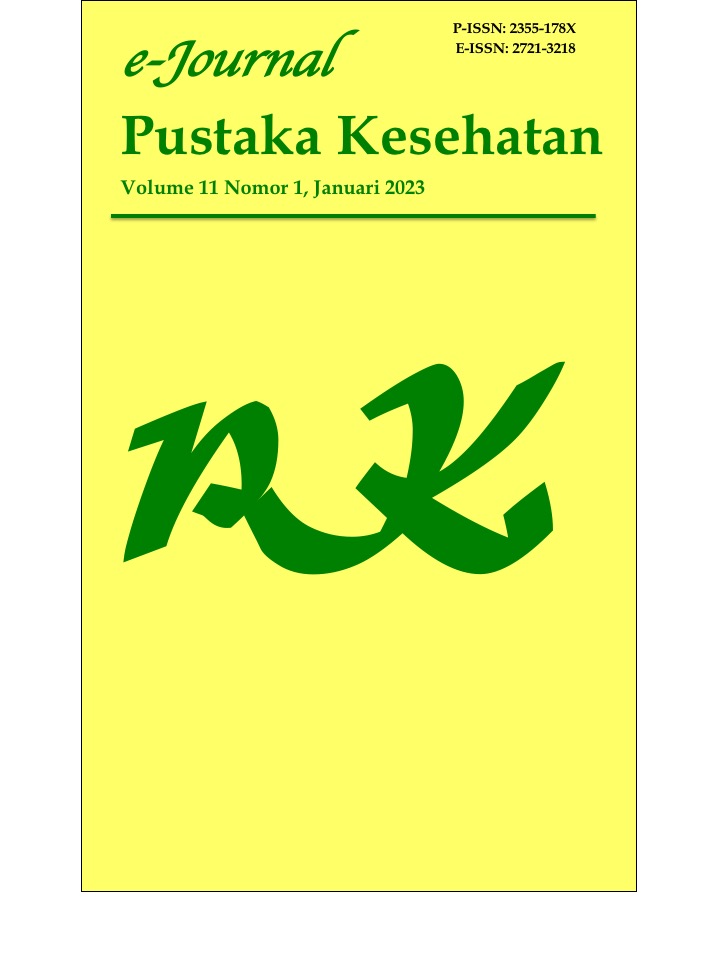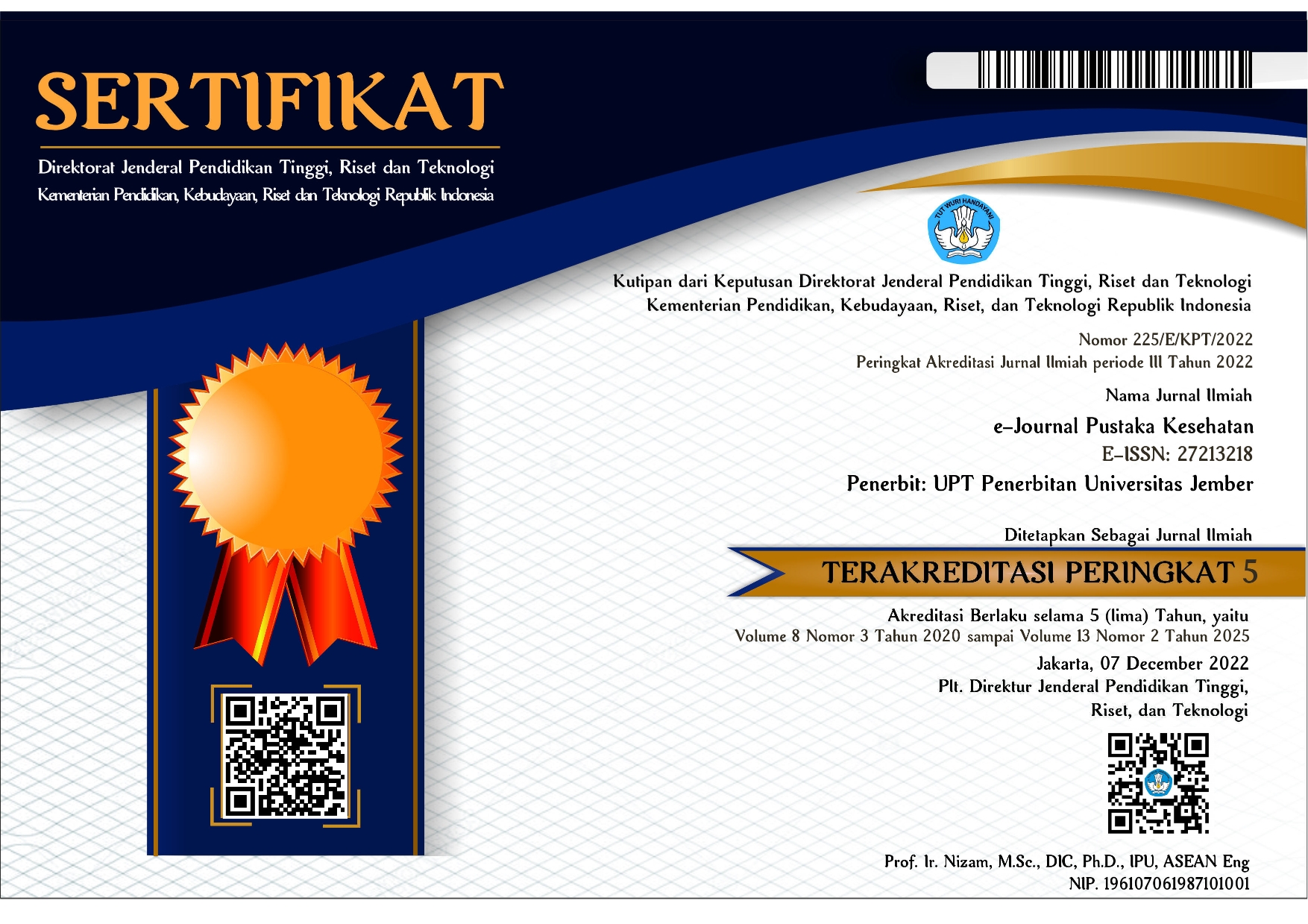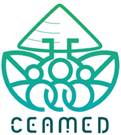Efektifitas Terapi Relaksasi Nafas Dalam dan Dzikir terhadap Kadar Gula Darah pada Klien DiabetesTipe II di RS Mitra Medika Bondowoso
DOI:
https://doi.org/10.19184/pk.v11i1.13952Keywords:
Deep breath relaxation, dzikir, blood sugar levelAbstract
Along with the increase in type II diabetes mellitus cases, various efforts made to control blood sugar levels of patients with type II diabetes mellitus include nonpharmacological interventions in deep breathing relaxation and dzikir therapy need to be considered. In addition to being easy and practical, it can be used for daily therapy used by people with diabetes mellitus. The purpose of the study was to determine the effectiveness of deep breath relaxation therapy and dhikir for blood sugar levels in clients of Type II Diabetes Mellitus in the Hospital of Mitra Medika Bondowoso. The research design used a two-group type pretest-posttest design with a total sample of 70 people divided into 2 groups of 35 groups each and given a different intervention that is deep breathing relaxation and dhikr using the Saturated Sampling technique. Then analyzed by Paired t-test and One Way Anova statistical test with significance level α ≤ 0.05 to find out the comparison between two different groups. The results showed that p value = 0.209 (p> 0.05) which means there was nosignificant difference between deep breathing relaxation therapy and dhikr therapy, meaning that it was equally effective in reducing blood sugar levels in clients of Diabetes Mellitus. The conclusion is that deep breath relaxation therapy and dzikir are effective against blood sugar levels in clients of Type II Diabetes Mellitus in the Hospital of Mitra Medika Bondowoso.
Downloads
References
[2] CDC, National Diabetes Statistics Report 2017: Estimates of Diabetes and Its Burden in the United States. United States: CDC; 2017
[3] Kementrian Kesehatan, infodatin: Pusat Data dan Informasi Kementrian Kesehatan, Jakarta; 2014.
[4] Dinas Kesehatan Bondowos, Profil Dinas Kesehatan Kabupaten Bondowoso tahun 2018. Bondowoso: Dinas Kesehatan Kabupaten Bondowoso; 2018.
[5] Gilda Sedgh and Rubina Hussain,, Reasons for Contraceptive Nonuse among Women Having Unmet Need for Contraception in Developing Countries, Studies in Family Planning; 2014. 45(2):151.
[6] Kozier, et al. dalam sukesi, Jurnal; 2016, 3, 2010: 914
[7] Soegondo, S, Diabetes Melitus, Penatalaksanaan Terpadu. Jakarta FKUI; 2007.
[8] Brunner dan Suddart, Keperawatan Medikal Bedah−Vol. 2 Ed.8, Jakarta:EGC; 201.
[9] Yahya Amar, Badan sehat ibadah jadi hebat. Jakarta; Gema Insani; 2016.
[10] Kholiq M, Pengaruh Dzikir Terhadap Penurunan Kadar Gula Darah Pada Pasien Diabetes Melitus Tipe II Di Puskesmas Kendal I Sukodono Kendal, Skripsi, S1 Tasawuf Dan Psikoterapi, Fakultas Ushuluddin Dan Humaniora, Universitas Islam Negeri Walisongo Semarang; 2016
[11] Rahman HF, Yulia, & Sukmarini L, Efikasi Diri, Kepatuhan, dan Kualitas Hidup Pasien Diabetes Melitus Tipe 2 (Self Efficacy, Adherence, and Quality of life of patients with Type 2 Diabetes). e-Jurnal Pustaka Kesehatan; 2017, 5(1).
[12] Nursalam, Metodologi Penelitian Ilmu Keperawatan: Pendekatan Praktis : Jakarta: Salemba Medika; 2013.
[13] Smeltzer, S.C. & Bare, B.G., Buku Ajar Keperawatan Medikal Bedah Brunner & Suddarth, edisi 8. Jakarta : EGC; 2013
[14] Irvine, C. and Taylor, N.F. Progressive Resistance Exercise improves Glycaemic Control in People With Type 2 Diabetes Mellitus: a systematic review. Australian Journal of Physiotherapy; 2009, 55: 237-246.
[15] Dunstan DW, Zimmet PZ, Wellborn TA, et all. The Raising Prevalence of Diabetes and Impaired Glucose Tolerance The Australia Diabetes Obesity and Lifestyle. Study Diabetes Care; 2002, 25: 829 – 834
[16] Indriyani RM, Terapi relaksasi nafas dalam (Deep Breathing) Dalam menurunkan Kadar Gula Darah Pada Pasien Diabetes Melitus Tipe 2; Jurnal Profesi Keperawatan; 2018, 2(4).
[17] Nurdin, dkk. Pengaruh Teknik Relaksasi terhadap Intensitas Nyeri pada Pasien Post Operasi Fraktur di Ruang Irina A BLU RSUP Prof. Dr. R. D. Kandou Manad.ejournal.unsrat.ac.id; 2013
[18] Wirya, Irwan & Sari, M, D. Pengaruh Pemberian Masase Punggung dan Teknik Relaksasi Nafas Dalam terhadap Penurunan Intensitas Nyeri pada Pasien Post Appendiktomi di Zaal C RS HKBP Balige Tahun 2011; 2013
[19] Hawari. Do'a dan Dzikir sebagai Pelengkap Terapi Medis. Jakarta: Diana Bakti Primayasa; 2008
[20] Warni, Dzikir dan Kesehatan Mental (studi Al-Qur‟an Surat Ar-Ra‟du Ayat 28 dalam Tafsir Al Ahzari; 2017
[21] Potter dan Perry. Fundamental Of nursing: Study guide and skills performance checklists, 6th ed, Australia, Elseiver-Mosby; 2005.
[22] Ng, T.P, Ma S.Z.N, Peak C.C, and Ee H.K.Religion, Health Beliefs and the Use of Mental Health Services by the Elderly.â€Aging & Mental Health, 2011. 15(2): 143–149.
[23] Notoatmodjo. Ilmu Prilaku kesehatan, Jakarta: Rineka cipta; 2014
[24] Mubarak, W. Promosi Keperawatan . Yogyakarta: Graha Ilmu; 2012
[25] Febriyanti, Dwi Evi. Hubungan Antara Pengetahuan Dengan Sikap Penderita Diabetes Melitus Dalam Menjalankan Terapi Diet Di Puskesmas II Kartasura. Skripsi FIK UMS. Surakarta, 2011.
[26] Darusman. Perbedaan Perilaku Pasien Diabetes Mellitus Pria dan Wanita dalam Mematuhi Pelaksanaan Diet. Berita Kedokteran Masyarakat; 2009, 25(1).
[27] Hawk, K. Using Self-Management skills to Adhere to Healthy Lifestyle Behavior; 2005
[28] Rahman HF, Istiqomah F, Lestari YD, Pengaruh Terapi Dzikir Terhadap Dismenorea Primer pada Remaja Putri.(the effect of dhikr therapy on primary Dysmenorrhea in Adolescent), Jurnal Sain Med; 2018, 10(1)
Downloads
Published
Issue
Section
License
e-Journal Pustaka Kesehatan has CC-BY-SA or an equivalent license as the optimal license for the publication, distribution, use, and reuse of scholarly work. Authors who publish with this journal retain copyright and grant the journal right of first publication with the work simultaneously licensed under a Creative Commons Attribution-ShareAlike 4.0 International License that allows others to share the work with an acknowledgment of the work's authorship and initial publication in this journal.







